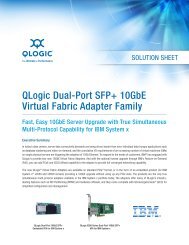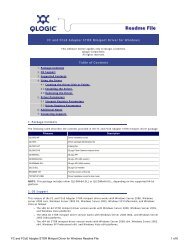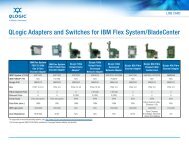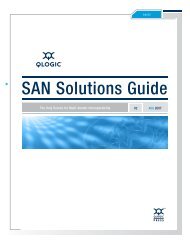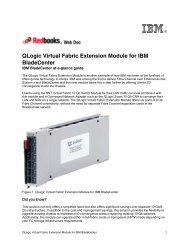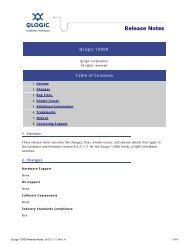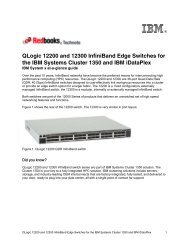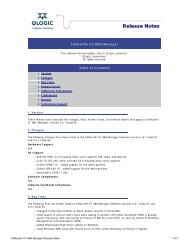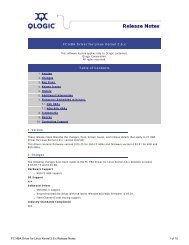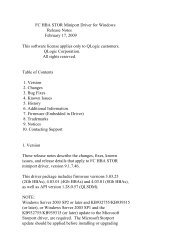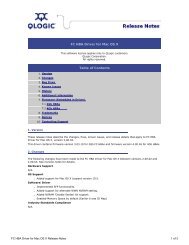Chapter 1. IBM Flex System FC3171 8 Gb SAN Switch - QLogic
Chapter 1. IBM Flex System FC3171 8 Gb SAN Switch - QLogic
Chapter 1. IBM Flex System FC3171 8 Gb SAN Switch - QLogic
Create successful ePaper yourself
Turn your PDF publications into a flip-book with our unique Google optimized e-Paper software.
SNMP trap configuration<br />
The SNMP trap configuration defines how traps are set. Choose from the tabs<br />
Trap1–Trap 5 to configure each trap. Table 15 describes the SNMP configuration<br />
parameters.<br />
Table 15. SNMP trap configuration parameters<br />
Parameter<br />
Trap Version<br />
Trap 1 Enabled<br />
Trap Address a<br />
Trap Community<br />
Description<br />
Specifies the SNMP version (1, 2, or 3) with which to format traps.<br />
Enables or disables the trap. If disabled, traps are not sent to trap monitoring<br />
stations and the trap settings are not configurable.<br />
Specifies the IP address to which SNMP traps are sent. A maximum of<br />
5 trap addresses are supported. The default address for trap 1 is<br />
10.0.0.254. The default address for traps 2–5 is 0.0.0.0.<br />
Trap community password (up to 32 characters) that authorizes an<br />
SNMP agent to receive traps. This field is write only. The value on the<br />
switch and the SNMP management server must be the same. The<br />
default is “public”.<br />
Trap Port 1 The port number on which the trap is sent. The default is 162.<br />
Trap Severity<br />
Trap User<br />
Users<br />
Specifies a severity level to assign to the trap. Open the drop-down list<br />
and choose a level. The Trap 1 Enabled option on the SNMP Properties<br />
dialog must be enabled to access this drop-down list. Trap severity levels<br />
include Unknown, Emergency, Alert, Critical, Error, Warning,<br />
Notify, Info, Debug, and Mark.<br />
The Trap User field becomes active when the V3 option is selected.<br />
Click the Users button to modify the contents of the Trap User<br />
drop-down list.<br />
The Users button becomes active when the V3 option selected in the<br />
Trap Version drop-down list. Click the Users button to open the<br />
SNMPv3 dialog from which to add/remove users from the list.<br />
Changes made to the user list will be updated in the user drop-down in<br />
the SNMP Properties dialog.<br />
a<br />
Trap address (other than 0.0.0.0) and trap port combinations must be unique. For example, if trap 1 and trap 2 have the<br />
same address, then they must have different port values. Similarly, if trap 1 and 2 have the same port value, they must<br />
have different addresses.<br />
SNMP v3 security<br />
Simple Network Management Protocol Version 3 (SNMPv3) is an interoperable<br />
standards-based protocol for network management. SNMPv3 provides secure<br />
access to devices by a combination of authenticating and encrypting packets over<br />
the network. SNMP v3 security is an additional layer of security offered with the 9.0<br />
firmware. The SNMP v3 security is available to a switch that has a secure<br />
connection, and can be configured only on the entry switch. The security features<br />
provided in SNMPv3 are:<br />
• Message integrity—ensuring that a packet has not been tampered with during<br />
transit.<br />
• Authentication—determining the message is from a valid source.<br />
• Encryption—scrambling the contents of a packet to prevent it from being seen by<br />
an unauthorized source.<br />
<strong>Chapter</strong> 4. Managing switches 67



